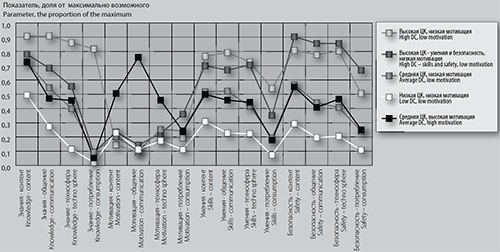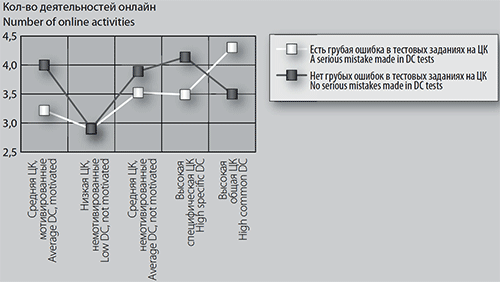Article
Soldatova Galina U., Rasskazova Elena I. (2016). Models of digital competence and online activity of Russian adolescents. National Psychological Journal. 2, 50-60.
Abstract
Having established the conception of digital competence consisting of four components (knowledge, skills, motivation and responsibility) implemented in four areas (content, communication, consumption, and the techno-sphere), we propose the idea of models of digital competence as a specific systems of adolescents’ beliefs about their abilities and desires in the online world. These models (1) may be realistic or illusory, (2) their development is mediated by the motivation and online activity and (3) they regulate further online activities as well as the further development of digital competence. On the basis of nationwide study of digital competence (N=1203 Russian adolescents of 12-17 years) using latent class method we revealed 5 models of digital competence corresponding to its lowest level, the average level at high and low motivation, high specific (in the components of skill and safety) and high general level. It has been shown that higher appraisal of their digital competence is related to the opportunity of a more prolonged and self-service access to the Internet as well as the history of independent development of skills online. The illusion of digital competence is associated with a wide but shallow exploration activities online. Motivational component is related to the participation and recognition of the role of others in the development of digital competence, in comparison with others’ online skills and knowledge, as well as subjectively lower «digital divide» with parents. We suggest that the motivational component of the digital competence is developed if adolescent has a successful interaction via Internet, learn from other people and also if the range of her activities and interests online activity involves and requires the development of new skills.
Based on digital competence model’s analysis, we have figured out 3 main types of Internet-users: (1) beginners, (2) experienced users, (3) advanced users. All these types fall into different risk groups, determined by variable possibilities of facing content-, communication-, technical- and customers- online-threats.
Accepted: 06/02/2016
Pages: 50-60
DOI: 10.11621/npj.2016.0205
PDF: Download
Keywords: digital competence; internet activity; online activities; adolescents; digital model of competence; the illusion of digital competence;
Available Online 30.08.2016
Table 1. Comparison of absolute and relative conformities figured out among models with diverse number of student groups.
|
Parameter |
2 groups |
3 groups |
4 groups |
5 groups |
6 groups |
|
LogLikelihood |
-1749,87 |
-1156,55 |
-900,15 |
-755,91 |
-565,37 |
|
Informational criteria |
|||||
|
AIC (Akaike information criteria) |
3597,74 |
2445,10 |
1966,30 |
1711,83 |
1364,74 |
|
BIC (Bayesian information criteria) |
3847,27 |
2781,21 |
2388,98 |
2221,09 |
1960,58 |
|
Sample-size adjusted BIC |
3691,63 |
2571,57 |
2125,34 |
1903,45 |
1588,94 |
|
Entropy |
0,90 |
0,91 |
0,85 |
0,88 |
0,84 |
|
Vuong-Lo-Mendell-Rubin Likelyhood ratio test (LRT) |
|||||
|
Double LogLikelihood Difference |
3860,97 |
1186,64 |
512,80 |
288,47 |
381,08 |
|
Medium (stand. dev.) |
117,63 (181,36) |
82,15 (290,66) |
163,65 (298,81) |
117,31 (313,63) |
89,30 (473,05) |
|
Significance level |
0,00 |
0,01 |
0,12 |
0,29 |
0,27 |
|
Relative Lo-Mendell-Rubin LRT test |
|||||
|
Test results |
3829,21 |
1176,88 |
508,59 |
286,10 |
377,95 |
|
Significance level |
0,00 |
0,01 |
0,12 |
0,30 |
0,27 |
|
Parametric LRT test, based on bootstrap (500 resamples) |
|||||
|
Double difference of LogLikelihood |
3860,97 |
1186,64 |
512,80 |
288,47 |
381,08 |
|
Significance level |
0,00 |
0,00 |
0,00 |
0,00 |
0,00 |
Figure 1. An average digital competence profile in 5 groups of adolescents.

Table 2. Average amount of online activity and applicable skills of adolescents and their parents (as viewed by adolescents).
|
Digital competence models |
Online activity – adolescents |
Online skill – adolescents |
Online activity - parents |
Online skills - parents |
|
Average DC, high motivation |
3,36 |
10,07 a |
2,77 a |
7,72 a |
|
Low DC, low motivation |
2,90 a,b |
5,19 a,b |
1,63 a,b,с |
3,19 a,b,с |
|
Average DC, low motivation |
3,66 a |
10,60 b |
1,99 a |
5,24 a,b |
|
High specific DC – skills and safety, low motivation |
3,77 b |
15,47 a,b |
2,29 b |
6,80 с |
|
High common DC |
3,99 |
17,77 a,b |
2,25 c |
7,43 b |
|
F-test |
19,75*** |
640,09*** |
15,42*** |
34,31*** |
|
Static eta effect |
0,25 |
0,83 |
0,22 |
0,32 |
|
Note. *** - p<0,001. a,b,c – Groups with the same letters differ pairwise if taken under post hoc analysis by Scheffe’s method with p<0,05. |
||||
Table 3. Peculiarities of online-activity among adolescents with different DC models.
|
Internet activity |
Average DC, motivated |
Low DC, not motivated |
Average DC, not motivated |
High specific DC – skills and safety |
High common DC |
A chi-squared test |
Static effect |
|
Searching for various interesting information |
62 (83,8%) |
402 (71,8%) |
293 (78,3%) |
85 (82,5%) |
68 (73,9%) |
11,46* |
0,10 |
|
Reading news |
11 (14,9%) |
135 (24,1%) |
117 (31,3%) |
27 (26,2%) |
32 (34,8%) |
14,29** |
0,11 |
|
Looking for new friends in social networks |
30 (40,5%) |
238 (42,5%) |
157 (42,0%) |
31 (30,1%) |
30 (32,6%) |
8,27 |
0,08 |
|
Various types of online communication |
28 (37,8%) |
192 (34,3%) |
182 (48,7%) |
47 (45,6%) |
48 (52,2%) |
25,38** |
0,14 |
|
Free-of-charge downloads |
25 (33,8%) |
101 (18,0%) |
103 (27,5%) |
36 (35,0%) |
29 (31,5%) |
26,54** |
0,15 |
|
Critics, quarrels, trolling |
2 (2,7%) |
13 (2,3%) |
19 (5,1%) |
9 (8,7%) |
12 (13,0%) |
26,55** |
0,15 |
|
Looking for data needed for studies/job |
37 (50,0%) |
264 (47,1%) |
191 (51,1%) |
52 (50,5%) |
48 (52,2%) |
1,88 |
0,04 |
|
Visiting educational websites, watching online-courses |
5 (6,8%) |
25 (4,5%) |
34 (9,1%) |
9 (8,7%) |
15 (16,3%) |
19,76** |
0,13 |
|
Programming |
2 (2,7%) |
13 (2,3%) |
25 (6,7%) |
4 (3,9%) |
13 (14,1%) |
29,21** |
0,15 |
|
Looking for part time job |
1 (1,4%) |
7 (1,3%) |
12 (3,2%) |
6 (5,8%) |
7 (7,6%) |
17,35** |
0,12 |
|
Online and mobile games |
27 (36,5%) |
159 (28,4%) |
121 (32,4%) |
47 (45,6%) |
39 (42,4%) |
16,98** |
0,12 |
|
Chatting with other online gamers while playing |
11 (14,9%) |
57 (10,2%) |
61 (16,3%) |
22 (21,4%) |
15 (16,3%) |
13,66** |
0,11 |
|
Looking for new arrivals in online-shops |
3 (4,1%) |
10 (1,8%) |
19 (5,1%) |
6 (5,8%) |
10 (10,9%) |
20,54** |
0,13 |
|
Online-purchases |
3 (4,1%) |
9 (1,6%) |
23 (6,1%) |
5 (4,9%) |
5 (5,4%) |
14,22** |
0,11 |
|
Creating and uploading new content |
5 (6,8%) |
7 (1,3%) |
31 (8,3%) |
8 (7,8%) |
6 (6,5%) |
28,95** |
0,15 |
|
Notes. * - p<0,05, ** - p<0,01. |
|||||||
Figure 2. Average number of online activities among adolescents with different DC models, making and not making serious grammar mistakes while being tested.

References:
Asmolov A.G., Semyonov A.L., Uvarov A.Yu. (2010) Russian school and new informational technologies: looking into the next decade. Moscow, NeksPrint.
Dendev B. (2013) Informational and communicative technologies in education. Moscow, IITO UNESKO.
Geiser, C. (2013) Data analysis with Mplus. New York, The Guilford Press.
Gilster P. (1997) Digital Literacy. N.Y., Wiley Computer Publishing.
(2009) How technology changes everything (and nothing) in psychology. 2008 annual report of the APA Policy and Planning Board. American Psychologist. 64, 454–463.
Ilomäki, L., Lakkala, M. & Kantosalo, A. (2011) What is digital competence? Linked portal. Brussels, European Schoolnet (EUN). 1–12.
Henson, R. K. (2006) Effect-Size Measures and Meta-Analytic Thinking in Counseling Psychology Research. The Counseling Psychologist. 34, 601–629.
Krichevets, A.N., Korneev, A.A., & Rasskazova, E.I. (2012) Mathematical statistics for psychologists. Moscow, Akademia.
Kuz’min, A.V., & Parshakova, A.V. (2013) Media- and informational literacy among educated societies. Moscow, MTsBS.
Lau, H. (2006) Manual on informational literacy for continuous life-lasting education. Moscow, Informatsiya dlya vsekh.
Madell, D., & Muncher, S. (2004) Back from the beach but hanging on telephone? English adolescents’ attitudes and experiences of mobile phone and the Internet. Cyberpsychology and Behavior. 7, 359-367.
Martin, A., & Madigan, D. (Eds.). (2006) Digital literacies for learning. L., Facet.
Mossberger, K., Tolbert, C.J., & McNeal, R.S. (2008) Digital citizenship: The internet, society, and participation. Cambridge, MA, MIT Press.
Soldatova, G.U., & Rasskazova, E.I. (2014) Adolescents’ safety in the Internet : risks, control and parent meditation. National Psychological Journal [Natsional’niy psikhologicheskiy zhurnal]. 3, 39−51. DOI: 10.11621/npj.2014.0305
Soldatova, G.V., & Rasskazova, E.I. (2014). Assessment of the digital competence in Russian adolescents and parents: Digital competence index. Psychology in Russia: State of the Art, 7.
Soldatova, G.U. et al. (2013) Digital competence of Russian adolescents and their parents: the results of a national-scale study. Moskow, Fond Razvitiya.
Soldatova, G.U., & Rasskazova, E.I. (2015) Modes of transmitting life experience among different generations in the context of Internet acquisition. Psychological Issues [Voprosy psikhologii]. 2, 56−66.
Soldatova, G.U., & Rasskazova, E.I. (2014) Psychological models of digital competence of Russian adolescents and their parents. National Psychological Journal [Natsional’nyy psikhologicheskiy zhurnal]. 2, 27−33. DOI: 10.11621/npj.2014.0204
UNESCO (2011) Teacher’s informational-communicative competence structure: UNESCO manual. Paris.
Zhilavskaya, I.V. (2014) Media-informational literacy in Russia: a road to the future. Proceedings of National science-practical conference “Media-and informational literacy in informational society” [Sbornik materialov Vserossiyskoy konferentsii “Media- i informatsionnaya gramotnost’ v informatsionnom obschestve”]. Moscow.
For citing this article:
Soldatova Galina U., Rasskazova Elena I. (2016). Models of digital competence and online activity of Russian adolescents. National Psychological Journal. 2, 50-60.


